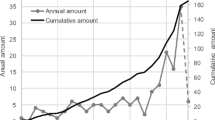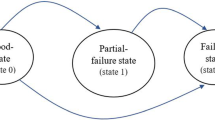Abstract
The key assumption in accelerated life testing is that the mathematical model concerning the lifetime of the item and the stress is known or can be assumed. In several situations, such life-stress relationships are not known and cannot be assumed, i.e. accelerated life testing information cannot be extrapolated to use situation. So, in such cases, a partially accelerated life test is a more appropriate testing method to be executed for which tested objects are subjected to both normal and accelerated circumstances. Due to continual improvement in manufacturing design, it is more difficult to obtain information about the lifetime of products or materials with high reliability at the time of testing under normal conditions. An approach to accelerate failures is the step-stress partially accelerated life test which increases the load applied to the goods in a particular discrete sequence. In this study, the maximum likelihood estimators of inverse the generalized inverse Lindley distribution parameters and the acceleration factor are investigated in a step-stress partially accelerated life test model utilizing two various types of progressively hybrid censoring systems. Furthermore, the performance of the model parameter estimators with the two progressive hybrid censoring schemes is analyzed and compared in terms of biases and mean squared errors using a Monte Carlo simulation approach.




Similar content being viewed by others
Data Availability
The data used in the simulation study was self-generated.
Code availability
There are no real data or data codes used in the research.
References
Epstein B (1954) Truncated life tests in exponential case. Ann Math Stat 25:555–564
Balakrishnan N, Kannan N, Lin CT, Ng HKT (2003) Point and interval estimation for Gaussian distribution based on progressive type-II censored samples. IEEE Tran Reliab 52:90–95
Balakrishnan N, Kannan N, Lin CT, Wu SJS (2004) Inference for the extreme value distribution under progressive type-II censoring. J Stat Comput Simul 74:25–45
Nassr SG, Elharoun NM (2019) Inference for exponentiated Weibull distribution under constant stress partially accelerated life tests with multiple censored. Commun Stat Appl Methods 26(2):131–148
DeGroot MH, Goel PK (1979) Bayesian and optimal design in partially accelerated life testing. Naval Res Logist 16(2):223–235
Bhattacharyya GK, Soejoeti Z (1989) A tampered failure rate model for step-stress accelerated life test. Commun Stat Theory Methods 18(5):1627–1643
Bai DS, Chung SW (1992) Optimal design of partially accelerated life tests for the exponential distribution under Type-I censoring. IEEE Trans Reliab 41(3):400–406
Bai DS, Chung SW, Chun YR (1993) Optimal design of partially accelerated life tests for the lognormal distribution under type-I censoring. Reliab Eng Syst Saf 40:85–92
Abdel-Ghani MM (1998) Investigation of some lifetime models under partially accelerated life tests, Ph.D. Thesis, Department of Statistics. Faculty of Economics and Political Science, Cairo University, Egypt.
Abdel-Ghani MM (2004) The estimation problem of the log-logistic parameters in step partially accelerated life tests using type-I censored data. Nat Rev Social Sci 41(2):1–19
Abd-Elfattah AM, Hassan AS, Nassr SG (2008) Estimation in step-stress partially accelerated life tests for the Burr type XII distribution using type I censoring. Stat Methodol 5(6):502–514
Zhang C, Shi Y, Wu M (2016) Statistical inference for competing risks model in step-stress partially accelerated life tests with progressively type-I hybrid censored Weibull life data. J Comput Appl Math 297:65–74
Bakoban R (2012) Estimation in step-stress partially accelerated life tests for the generalized inverted exponential distribution using type I censoring. Am J Sci Res 3:25–35
Ismail AA, Aly HM (2010) Optimal planning of failure-step stress partially accelerated life test under type II censoring. J Stat Comput Simul 80(12):1335–1348
Ismail AA (2010) Bayes estimation of Gompertz distribution parameters and acceleration factor under partially accelerated life tests with type I censoring. J Stat Comput Simul 80(11):1253–1264
Mohamed AER, Abu-Youssef SE, Ali NS, El-Raheem AA (2018) Inference on constant accelerated life testing based on geometric process for extension of the exponential distribution under type-II progressive censoring. Pak J Stat Oper Res 14(2):233–251
Almarashi AM (2020) Parameters estimation for constant-stress partially accelerated life tests of generalized half-logistic distribution based on progressive type-II censoring. Revstat Stat J 18(4):437–452
Zheng D, Fang X (2017) Exact confidence limits for the acceleration factor under constant-stress partially accelerated life tests with type-I censoring. IEEE Trans Reliab 67(1):92–104
Alam I, Intezar MA, Ahmed A (2021) Costs of maintenance service policy: a new approach on constant stress partially accelerated life test for generalized inverted exponential distribution. Reliab Theory Appl 16(2):45–57
Alam I, Islam AU, Ahmed A (2019) Parametric estimation on constant stress partially accelerated life tests for the exponentiated exponential distribution using multiple censoring. Reliab Theory Appl. 14(4):20–32
Alam I, Ahmed A (2020) Parametric and interval estimation under step-stress partially accelerated life tests using adaptive type-II progressive hybrid censoring. Ann Data Sci. https://doi.org/10.1007/s40745-020-00249-1
Ling L, Xu W, Li M (2009) Parametric inference for progressive type-I hybrid censored data on a simple step-stress accelerated life test model. Math Comput Simul 79(10):3110–3121
Alam I, Anwar S, Sharma LK, Ahmed A (2022) Competing risk analysis in constant stress partially accelerated life tests under censored information. Ann Data Sci. https://doi.org/10.1007/s40745-022-00401-z
Lone SA, Alam I, Rahman A (2022) Statistical analysis under geometric process in accelerated life testing plans for generalized exponential distribution. Ann Data Sci. https://doi.org/10.1007/s40745-022-00397-6
Alam I, Ahmed A (2021) Inference on maintenance service policy under step-stress partially accelerated life tests using progressive censoring. J Stat Comput Simul 92(4):813–829
Almalki SJ, Farghal AWA, Rastogi MK, Abd-Elmougod GA (2022) Partially constant-stress accelerated life tests model for parameters estimation of Kumaraswamy distribution under adaptive type-II progressive censoring. Alex Eng J 61(7):5133–5143
Çetinkaya Ç (2021) Estimation in step-stress partially accelerated life tests for the power lindley distribution under progressive censoring. Gazi Univ J Sci 34(2):579–590
Shi Y (2022) Advances in big data analytics: theory, algorithm and practice. Springer, Singapore
Olson DL, Shi Y (2007) Introduction to business data mining. McGraw-Hill/Irwin, New York
Shi Y, Tian YJ, Kou G, Peng Y, Li JP (2011) Optimization based data mining: theory and applications. Springer, Berlin
Tien JM (2017) Internet of things, real-time decision making, and artificial intelligence. Ann Data Sci 4(2):149–178
Sharma V, Singh S, Singh U, Agiwal V (2015) The inverse Lindley distribution: a stress-strength reliability model with applications to head and neck cancer data. J Ind Prod Eng 32(3):162–173
Sharma VK, Singh SK, Singh U, Merovci F (2016) The generalized inverse Lindley distribution: a new inverse statistical model for the study of upside-down bathtub data. Commun Stat Theory Methods 45(19):5709–5729
Alkarni SH (2015) Extended inverse Lindley distribution: properties and application. Springerplus 4(1):1–13
Hassan AS, Nassr SG (2019) Power Lindley-G family of distributions. Ann Data Sci 6:189–210
Kundu D, Joarder A (2006) Analysis of type-II progressively hybrid censored data. Comput Stat Data Anal 50:2509–2528
Lin CT, Ng HKT, Chan PS (2009) Statistical inference of type-II progressively hybrid censored data with Weibull lifetimes. Commun Stat Theory Methods 38:1710–1729
Ng HKT, Kundu D, Chan PS (2009) Statistical analysis of exponential lifetimes under an adaptive hybrid type-II progressive censoring scheme. Naval Res Logist 56:687–698
Miller RC (1981) Survival analysis. Wiley, NewYork
Funding
The author received no specific funding for this study.
Author information
Authors and Affiliations
Contributions
All authors equally contributed. They read and approved the manuscript.
Corresponding author
Ethics declarations
Conflict of interest
The authors declare that they have no competing interest.
Ethical statements
This article does not contain any studies involving human participants performed byany of the authors.
Additional information
Publisher's Note
Springer Nature remains neutral with regard to jurisdictional claims in published maps and institutional affiliations.
Rights and permissions
Springer Nature or its licensor (e.g. a society or other partner) holds exclusive rights to this article under a publishing agreement with the author(s) or other rightsholder(s); author self-archiving of the accepted manuscript version of this article is solely governed by the terms of such publishing agreement and applicable law.
About this article
Cite this article
Alam, I., Kamal, M., Intezar, M.T. et al. Statistical Analysis from the Generalized Inverse Lindley Distribution with Adaptive Type-II Progressively Hybrid Censoring Scheme. Ann. Data. Sci. 11, 479–506 (2024). https://doi.org/10.1007/s40745-022-00453-1
Received:
Revised:
Accepted:
Published:
Issue Date:
DOI: https://doi.org/10.1007/s40745-022-00453-1




